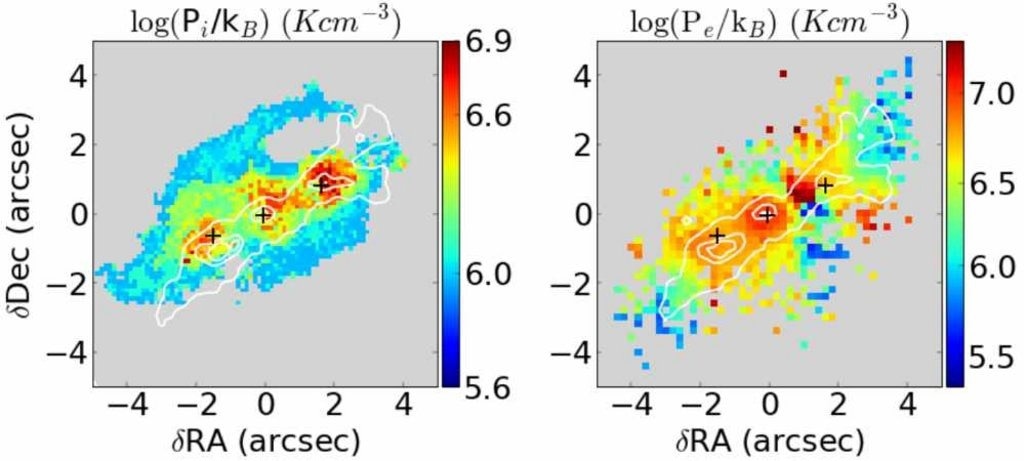Reviewed by Alex SmithJul 25 2022
Using data from the Atacama Large Millimeter Array (ALMA) and Very Large Telescope (VLT) of the European Southern Observatory (ESO), a European team of astronomers measures the gas pressure and studies how the powerful jets of a supermassive black hole alter the conditions for star formation in interstellar clouds.
 The pressure maps of IC 5063. The left panel shows the internal pressure of molecular clouds as measured from CO and HCO+ emission lines. The right panel shows the pressure of the ionized medium as measured from ionized sulfur and nitrogen emission lines. This pressure is considered external to molecular clouds. Crosses mark the position of the radio core and white contour lines the jet trail as traced by the Hubble Space Telescope Wide Field Planetary Camera 2 narrow-band image. Image Credit: University of Cologne.
The pressure maps of IC 5063. The left panel shows the internal pressure of molecular clouds as measured from CO and HCO+ emission lines. The right panel shows the pressure of the ionized medium as measured from ionized sulfur and nitrogen emission lines. This pressure is considered external to molecular clouds. Crosses mark the position of the radio core and white contour lines the jet trail as traced by the Hubble Space Telescope Wide Field Planetary Camera 2 narrow-band image. Image Credit: University of Cologne.
A European group of astronomers headed by Professor Kalliopi Dasyra of the National and Kapodistrian University of Athens, Greece, under the participation of Dr. Thomas Bisbas from the University of Cologne, modeled numerous emission lines in the Atacama Large Millimeter Array (ALMA) and Very Large Telescope (VLT) observations to quantify the gas pressure in both ambient clouds and jet-impacted clouds.
With these unparalleled predictions, reported recently in the journal Nature Astronomy, the researchers found out that the jets considerably alter the internal and external pressure of molecular clouds in their path.
In the same galaxy, it is possible for clouds to compress and start star formation as well as for clouds to dissipate and delay star formation, depending on which of the two pressures changes the most.
Our results show that supermassive black holes, even though they are located at the centers of galaxies, could affect star formation in a galaxy-wide manner studying the impact of pressure changes in the stability of clouds was key to the success of this project. Once few stars actually form in a wind, it is usually very hard to detect their signal on top of the signal of all other stars in the galaxy hosting the wind.
Kalliopi Dasyra, Professor, Department of Astrophysics, Astronomy, & Mechanics, Faculty of Physics, National and Kapodistrian University of Athens
It is thought that supermassive black holes are situated at the center of the majority of the galaxies in the Universe.
When particles that were incursive onto such black holes have been trapped by magnetic fields, they could be ejected outwards and travel further inside galaxies in the form of huge and strong jets of plasma.
Such jets tend to be frequently perpendicular to galactic disks. But in a galaxy 156 million light years away called IC 5063, the jets are actually generating inside the disk, thereby interacting with dense and cold molecular gas clouds.
From this interaction, compression of jet-impacted clouds has been theorized to be possible. This results in gravitational instabilities and, finally, star formation as a result of the gas condensation.
For the experiment, the research group utilized the emission of formyl cation (HCO+) and carbon monoxide (CO) provided by ALMA and the emission of ionized nitrogen and ionized sulfur offered by VLT. They then made use of sophisticated and innovative astrochemical algorithms to spot the environmental conditions in the outflow and the encircling medium.
Such environmental conditions comprise data regarding the strength of the far-ultraviolet radiation of stars. This is the rate at which relativistic charged particles ionize the gas, and then the mechanical energy is deposited on the gas by the jets.
Narrowing down such conditions disclosed the densities and gas temperatures illustrative of various parts of this galaxy, which were further utilized to offer pressures.
“We have performed many thousands of astrochemical simulations to cover a wide range of possibilities that may exist in IC 5063,” stated co-author Dr. Thomas Bisbas, DFG Fellow of the University of Cologne and former postdoctoral researcher at the National Observatory of Athens.
A challenging aspect of the work was to carefully determine as many physical constraints as possible to the analyzed range that every parameter could have.
This way, we could get the optimal combination of physical parameters of clouds at different locations of the galaxy.
Georgios Filippos Paraschos, Study Co-Author and PhD Student, Max Planck Institute for Radio Astronomy
Georgios Filippos Paraschos was a Master’s student at the National and Kapodistrian University of Athens.
As a matter of fact, pressures were not just quantified for a few locations in IC 5063. Rather, maps of this and other quantities in the center of this galaxy were made. Such maps enabled the authors to envision how the gas properties shift from one location to another due to the jet passage.
At present, the team is looking forward to using the James Webb Space Telescope for additional investigations of the pressure in the outer cloud layers, as probed by the warm H2.
We are truly excited about getting the JWST data as they will enable us to study the jet-cloud interaction at an exquisite resolution.
Kalliopi Dasyra, Professor, Department of Astrophysics, Astronomy, & Mechanics Faculty of Physics, National and Kapodistrian University of Athens
Journal Reference:
Dasyra, K. M., et al. (2022) Insights into the collapse and expansion of molecular clouds in outflows from observable pressure gradients. Nature Astronomy. doi.org/10.1038/s41550-022-01725-9